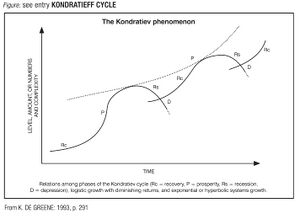KONRATIEFF CYCLE
| Collection | International Encyclopedia of Systems and Cybernetics |
|---|---|
| Year | 2004 |
| Vol. (num.) | 2(1) |
| ID | ◀ 1842 ▶ |
| Object type | Discipline oriented, Methodology or model |

A more or less cyclical evolution of about 50 to 60 years discovered in economy by N.D. KONDRATIEFF.
This Russian economist published several papers on the topic from 1922 to 1928. The reality of the KONDRATIEFF oscillation seems now well established, even if their is some fuzziness about the phenomenon.
The subject has been reviewed recently by K. DE GREENE, who writes:
- “The following would appear to be, systems theoretically, the necessary and sufficient conditions for the generation of the KONDRATIEFF phenomenon:
- “1. The older system-field evolves or is driven far-from-equilibrium into a domain of instability (e.g. by overproduction of capital), and powerful forces try to restore the system to equilibrium. Temporary steady-state is lost.
- “2. At critical distance of levels, system evolution may bifurcate along alternate pathways (e.g. toward a stock market crash).
- “3. Fluctuations or mutations stochastically may occur (e.g. an emerging paradigm of knowledge or a technical invention).
- “4. Deterministic nonlinear interaction laws permit positive-feedback-mediated autocatalytic and cross-catalytic growth of fluctuations into nucleations (e.g. an optimistic group in a population)
- “5. The large sociotechnical system or environment attempts to damp the growth of the nucleation, and conflict arises (e.g. between older and newer way of organizing work)
- “6. The nucleation triumphs, and system evolution bifurcates along its pathway, producing a new, irreversible self-organization that takes over the qualitatively changed system-field (e.g. a new dominant technology).
- “7. Processes 1-6 repeat themselves, producing cascades of bifurcations and structural changes (e.g. technological change impacting organization design, in turn impacting economic growth)” (1988, p.291).
DE GREENE gives also a more formal interpretation of the KONDRATIEFF phenomenon and writes: “With certain simplifying assumptions (e.g. with regard to potential functions), systems dynamics and catastrophe theory can fit nicely into the broader framework of dissipative structure theory” (p.292).
Another author who extensively researched the long-waves subject in economy and other fields is F. MEYER (1954 and 1974).
The KONDRATIEFF quasi-cycle seems to be an envelope curve for cycles of lesser periods. In DE GREENE's words: “The economic long wave (my ”Kondratieff cycle-structure“) is an order parameter (1994, p.13). Its imperfect regularity reflects probably somewhat conflicting determinisms of various factors which act simultaneously and produce a global chaotic determinism that does not anyway becomes dominant.
DE GREENE also considers the possibility to develop a theory of KONDRATIEFF waveforms as dissipative structures, in accordance with PRIGOGINE's opinion that all self-organizing systems go through cycles of becoming, growing, changing and decaying (see G. NICOLIS & I. PRIGOGINE, 1977).
For a review of forecasting in KONDRATIEFF's cycle terms, see K.DE GREENE (1993, p.41-55).
An intriguing possibility would be the existence of a similar (or still longer period) cycle in the evolution of ecosystems and social systems. A systemic inquiry in these fields could be rewarding. P. SOROKIN's now nearly forgotten (and somewhat shaky) investigations in historical cycles could possibly be reconsidered in such new terms.
See also
'figure below'Self-similarity in the WEIERSTRASS function.